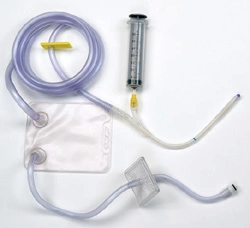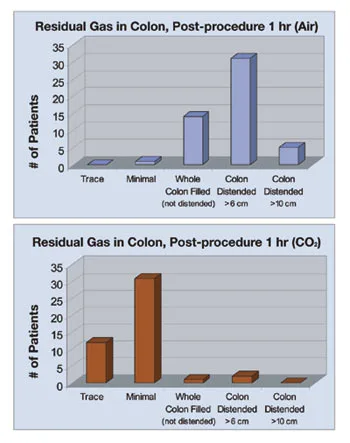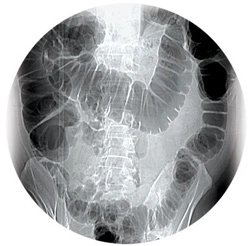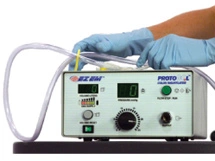PROTOCO2LTM
An essential component for successful Virtual Colonoscopy
PROTOCO2LTM is a unique system that fully automates the insufflation process, freeing staff for other duties. Since CO2 is rapidly absorbed, insufflation with CO2 results in improved patient comfort after the procedure.
An ACRIN CT-Colonography Trial Standard1
Virtual Colonoscopy, or CT Colonography, is becoming increasingly accepted as a screening method for colorectal cancer. The American Cancer Society has included Virtual Colonoscopy in its Guideline on Screening and Surveillance for the Early Detection of Colorectal Cancer and Adenomatous Polyps as an acceptable option for Colorectal Cancer Screening.2
Optimal colonic distention is a critical requirement for obtaining an optimal Virtual Colonoscopy study.3
Advantages to Automated Insufflation with Carbon Dioxide
Patient Comfort: Carbon dioxide is more rapidly resorbed than room air and may improve patient comfort after completion of the examination.3
Consistent Distension: Automated insufflation to a constant pressure takes the guesswork out of determining if the patient is adequately distended.
Productivity: Automated insufflation may decrease the demands on staff time.3
PROTOCO2LTM INSUFFLATION SYSTEM
- Automated insufflation helps improve productivity by freeing up practitioner3
- Regulated pressure avoids spikes and minimizes patient discomfort that can occur with hand insufflation5
- Over-pressure alarms and safety shutdown features help assure patient safety
- Pressure can be adjusted for different patient requirements or during a procedure
- No special utilities required: PROTOCO2LTM uses standard medical grade (USP) D or E size carbon dioxide cylinders and connects to standard hospital electrical receptacle
- PROTOCO2LTM displays instantaneous gas pressure, records the total volume delivered during the procedure, and alerts the operator when the CO2 cylinder is low
- Accessory cart features storage for CO2 cylinders and holder for administration set
PROTOCO2LTM ADMINISTRATION SET

- Simple connection and removal from PROTOCO2LTM Insufflator
- In-line fluid trap captures colon effluent and removes it from the "path" of the carbon dioxide for proper insufflation
- Hydrophobic filter helps protect the PROTOCO2LTM Insufflator from cross-contamination
COMFORT AND SAFETY

Rapid absorption of CO2 results in improved comfort after the procedure, as compared with room air insufflation.3, 4, 5
Automated low-pressure insufflation may reduce colonic spasm as compared with manual methods, particularly in segments with advanced diverticular disease.5
Helps ensure patient safety through redundant pressure relief valves and automatic flow stop features, which protect against over-insufflation.
A choice of tips for rectal administration allows the practitioner to select the most comfortable tip for the patient.
In our experience, we have found that automated CO2 delivery is not only safe but also results in improved colonic distention compared with manual techniques and also that use of CO2 compared with room air results in less post procedural discomfort." 6
- Pickhardt PJ. Radiology 2006; 239 (2):313-316.
A study on minimizing post-colonoscopy abdominal pain showed that 1 hour after colonoscopy, a majority of patients insufflated with room air had significant residual gas in the colon. The study showed that 94% of patients insufflated with carbon dioxide had only trace to minimal residual gas.7
CONSISTENCY

Regulated pressure gradually distends the colon, and maintains that pressure for the duration of the study.
Automated insufflation with CO2 results in more consistent distention and less variability from technologist to technologist.8
Improved distention, as compared to manual room air insufflation, has been shown in two clinical trials.4, 8
Volume display allows the monitoring and recording of the volume of CO2 used, unlike room air insufflation, where the amount of air introduced is not evident.
We found significantly better luminal distention overall using automated administration than using the manual method." 4
- Burling D, et al. AJR 2006; 186:96-103.
PRODUCTIVITY

Automated operation helps reduce staff time during insufflation process.3
Replaces gas lost during the procedure automatically.
Visual displays allow quick reference of pressure and volume, and alerts the operator when the CO2 cylinder is low.
Adjustable pressure up to 25 mmHg allows for user control when desired.
The CT technologists at my institution unanimously prefer the automated CO2 technique over manual methods. They cite a more clearcut point to begin scanning, a diminished need for coaching patients, and decreased operator dependence." 5
- Pickhardt P.J. AJR 2007; 189:290-298.
1) The National CT Colonography Trial: assessment of accuracy in participants 65 years of age and older.
Johnson CD, Herman BA, Chen MH, Toledano AY, Heiken JP, Dachman AH, Kuo MD, Menias CO, Siewert B, Cheema JI, Obregon R, Fidler JL, Zimmerman P, Horton KM, Coakley KJ, Iyer RB, Hara AK, Halvorsen RA Jr, Casola G, Yee J, Blevins M, Burgart LJ, Limburg PJ, Gatsonis CA. Radiology. 2012 May;263(2):401-8. Epub 2012 Feb 23.
2) Screening and surveillance for the early detection of colorectal cancer and adenomatous polyps, 2008: a joint guideline from the American Cancer Society, the US Multi-Society Task Force on Colorectal Cancer, and the American College of Radiology.
Levin B, Lieberman DA, McFarland B, Andrews KS, Brooks D, Bond J, Dash C, Giardiello FM, Glick S, Johnson D, Johnson CD, Levin TR, Pickhardt PJ, Rex DK, Smith RA, Thorson A, Winawer SJ; American Cancer Society Colorectal Cancer Advisory Group; US Multi-Society Task Force; American College of Radiology Colon Cancer Committee.Gastroenterology. 2008 May;134(5):1570-95. Epub 2008 Feb 8. Review.
3) Advice for optimizing colonic distention and minimizing risk of perforation during CT colonography.Dachman AH.
Radiology. 2006 May;239(2):317-21. No abstract available.
4) Automated insufflation of carbon dioxide for MDCT colonography: distension and patient experience compared with manual insufflation.
Burling D, Taylor SA, Halligan S, Gartner L, Paliwalla M, Peiris C, Singh L, Bassett P, Bartram C.AJR Am J Roentgenol. 2006 Jan;186(1):96-103.
5) Screening CT colonography: how I do it.
Pickhardt PJ.AJR Am J Roentgenol. 2007 Aug;189(2):290-8.
6) Incidence of colonic perforation at CT colonography: review of existing data and implications for screening of asymptomatic adults.
Pickhardt PJ.Radiology. 2006 May;239(2):313-6. Review. No abstract available.
7) Minimizing postcolonoscopy abdominal pain by using CO(2) insufflation: a prospective, randomized, double blind, controlled trial evaluating a new commercially available CO(2) delivery system.
Sumanac K, Zealley I, Fox BM, Rawlinson J, Salena B, Marshall JK, Stevenson GW, Hunt RH.Gastrointest Endosc. 2002 Aug;56(2):190-4.
8) Patient-controlled room air insufflation versus automated carbon dioxide delivery for CT colonography.
Shinners TJ, Pickhardt PJ, Taylor AJ, Jones DA, Olsen CH.AJR Am J Roentgenol. 2006 Jun;186(6):1491-6.
9) Neri E., et al. Eur Radiol 2012 on-line.
10) Courtesy of Dr. Perry J. Pickhardt, University of Wisconsin, Madison, USA.
|
MDCT E-lectures |
View | |||
PROTOCO2LTM Insufflation System
- Automated insufflation helps improve productivity by freeing up practitioner (3)
- Regulated pressure avoids spikes and minimizes patient discomfort that can occur with hand insufflation (5)
- Over-pressure alarms and safety shutdown features help assure patient safety
- Pressure can be adjusted for different patient requirements or during a procedure
- No special utilities required: PROTOCO2LTM uses standard medical grade (USP) D or E size carbon dioxide cylinders and connects to standard hospital electrical receptacle
- PROTOCO2LTM displays instantaneous gas pressure, records the total volume delivered during the procedure, and alerts the operator when the CO2 cylinder is low
- Accessory cart features storage for CO2 cylinders and holder for administration set
| Cat. N° | Description |
|---|---|
| 390301 | PROTOCO2LTM Automated CO2 Colon Insufflator for Virtual Colonoscopy |
| 390305 | System Rolling Cart |
| 390401 | Administration Set with latex-free Flexi-Cuff® retention tip for single-use insufflation |
| 390402 | Administration Set with small catheter and retention cuff (latex-free 20 Fr. Catheter with retention cuff) for single use insufflation |
PROTOCO2LTM Administration Set
- Simple connection and removal from PROTOCO2LTM Insufflator
- In-line fluid trap captures colon effluent and removes it from the "path" of the carbon dioxide for proper insufflation
- Hydrophobic filter helps protect the PROTOCO2LTM Insufflator from cross-contamination

Contact us
Please fill out the form below and we will get back to you.
DISCLAIMER – IMPORTANT SAFETY INFORMATION
The PROTOCO2L™ Colon Insufflator administers and regulates carbon dioxide as a distention media to the colon during CT Colonography (CTC or Virtual Colonoscopy) and conventional Colonoscopy.
The PROTOCO2L™ Colon Insufflator should be used only when colon insufflation is indicated, and should therefore not be used for any other treatments. It should only be used under the direct guidance of a physician experienced in colon insufflation.
This device is contraindicated for hysteroscopic insufflation, i.e., it must not be used for intrauterine distention.
This product should not be used in patients with known or suspected colonic perforation or toxic megacolon. It should not be used within 6 days of large forceps or "hot" biopsy, or snare polypectomy.
Do not use this product in a colostomy stoma.
Do not use this product following recent rectal surgery or low rectal anastomosis, or when proctitis or other rectal conditions such as inflammatory or neoplastic diseases are suspected.